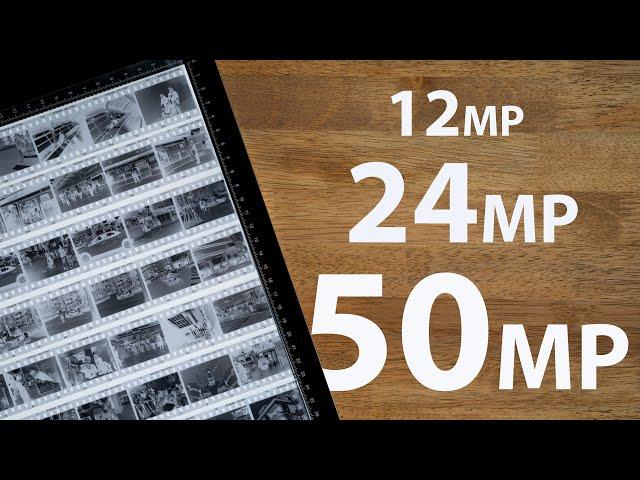
Do Megapixels Matter When Converting Negatives With A Digital Camera
Комментарии:

Very interesting and well done comparison. I just wondered if the grain can be reduced with a noise reducing program, like Neat Image.
Ответить
Nicely done, thank you. 👍
That's a comparison on point.

What it really goes to show you is how much more information medium format film has than any of the other formats haha
Ответить
Are all three of your cameras full frame? I'd be interested to see the differences of a 24MP cropped frame (Nikon D5500) and a 45MP full frame (Nikon D850) for 35mm and medium format.
Ответить
Interesting. I want to see more examples of this done by different content creators. I want to see the difference.
Ответить
Interesting. I wonder how these findings translate to larger format negatives and transparencies. I have a bunch of negatives from a Mamiya RB67 and some 4x5. I just assumed they would need a higher resolution sensor, but maybe not.
Ответить
The a7 iv, with the 33 M would be a good compromised
Ответить
Use a fujifilm X-T2 to scan and the x-trans sensor messes the grain up big time. Get much better results from my canon 5D mark iii
Ответить
It really just depends how large you’d want to print the digital file.
Ответить
Might want to consider the resolving power of the lens used on the 50mp since glass also has limitations with regards to how much detail is transmitted if the glass was designed in a time period where the peak mp of cameras was around 24 you will likely start seeing glass imperfections the higher you go on resolving power with the sensor.
Ответить
WOW, thank you so much!!!!!
Ответить
The grains on 50MP are much more detailed and defined but may appear "noisy" but that's what it really looks like when zoomed in. The 24MP just cannot capture enough details of grains so they come out as "smooth."
Ответить
Something to consider, more megapixels means more color information and the more post processing you can do
Ответить
I'm not sure about your results. It depends a lot on your film speed. A couple frames on Agfa APX 25 that I had scanned at a professional digital printing and scanning shop needed their 70mp drum scanner to capture all the detail in the images. But other shots on a more standard Ilford HP5 plus looked great closer to 20mp.
It also depends on how you intend to crop or enlarge, if you will print or use online.
70mp is expensive and huge so save that for when needed, but storage is soooo cheap that it seems like a waste of time to scan at low resolutions, especially if that means you have to scan again.
And unless you are a wedding photographer you aren't digitizing all of your images so is file size really that important?

You are comparing your shooting technique and lens quality vs. a macro and critically focused sensor.
Film shot with perfect technique (just a tripod and perfect focus) will give you much more resolution than eqvl 24MP.
You can never have too much resolution when scanning film.
The “digital” grain is interference beating known as grain aliasing, because your resolution is not high enough.

Do I really need special software for this? Why can't I just invert the image, and then white-balance out the base negative color?
Ответить
I vote for the 24 mp
Ответить
Dynamic range is a big factor, too. Digital cameras are getting better, but I'd be curious to see a dynamic range comparison with top end flatbed and drum scanners specifically for dynamic range
Ответить
Do you ever print old school with an enlarger?
Ответить
A few years ago I digitalized 1600 35mm slides using a Sony RX100m3 - i.e a 20MP. 1" sensor. Blown up to a maximum I could easily see the grain of the film. The slides were taken between 1972 and 1983. The actual achievable resolution of the slides seemed to have been around 16MP.
Ответить
You need to mask off all the extraneous light from the edges of that light box! it WILL cause degradation of the blacks in the film frame!!!
Ответить
I owned a $400,000 Kodak Pro Photo CD film scanning system from 1993 to 2007 which used true RGB linear scanning arrays and Schneider apochromatic lenses . We could scan 35mm frames up to 4k x 6k resolution (24MP) at 16bit Lab colour but we did this rarely as scans of our studio calibration photos (taken on EVERY film stock) showed that only Kodachrome 25 ASA (ISO now) transparencies shot in ideal studio lit conditions with the very best lenses and apertures could provide enough film detail to justify this, 24MP resolution. We did over two million scans for archive producers and movie companies (all the stills for Star Wars etc.) and nobody ever wanted more that the 4k x 6k Pro resolution. It was the 16bit tonal range and the hundreds of custom negative and positive film terms developed by Kodak and us that made the scanning quality the best in the world! David Myers, Digital Masters Australasia.
Ответить
Answer: Not with ON1 PhotoRaw AI resize and sharpen. Old Polaroid prints have been resurrected!
The Nikon D700 with its fantastic colour rendition now comes back into its own.

The lower the better, as you cant print from these files anyhow. So you want them to be as close to the use size as possible so there will be least amount of scaling that degrades image quality.
Ответить
Really , really interesting results ! Bravo ! Perhaps the 50 mp would be useful for slide film where the detail is comparatively extremely high when shot properly. For higher ISO BW, I definitely think lower MP ( 12-16) will 'support' the film look better.
Ответить
Totally wrong. Use a high end flatbed or do it right and use a drum scanner. Use silverfast software. One needs a 600 or 1200 dpi scan.
Ответить
Daily use 23 inch PC monitier has only 2 mega pixels (1920*1080) and we cannot tell the difference of desolution avobe this level with our eyes.
Ответить
I use gfx 102 mp, good results. lens canon macro 65mm 2.8
Ответить
Man I’m sooo glad I just found this video, I shoot with an X-Pro3 (26MP) as well as an M6 and a Hassy 501cm and just ordered the 80mm fuji macro to “scan” my film negatives, thank you for this Awesome experiment.
Ответить
Not quite 'future generation' just yet after only 2 years, but this is already a really helpful archive video. :)
Thanks Darryl. 👍

Great info thank you
Ответить
*A7C.
Great video though, interesting to see!

I think that a lot depends on the capability of specific lens to support high megapixel camera. For example, if this macro lens on 50mpix camera have max resolution about 32mpix, than of cause will be hard to see the difference between images made at 24mpix resolution. Second, it is important to have high resolution lens on film camera. Old lenses frequently not delivering more than 24mpix on 35mm camera. Third argument - for medium format film, if old lens has good resolution and we compare image scanned by 50 mpix Sony camera with an image scanned by 50 mpix Fujifilm GFX camers. The same image from GFX camera will looks better because optically it is easier to receive high resolution image on bigger sensor.
Ответить
The top of the line Minolta scanner Dimage 5400 from the early 2000s outputs 40MP files (or life-size 24x36mm frames at effective 5400dpi). This was considered overkill by some and this kind of resolution wasn't exactly worth it unless you were shooting film with high-resolving power with a very sharp lens on a stable platform. From your test, I definitely prefer the 50MP files showing the grain structure - those are actual silver halide crystals you are seeing. Although I agree that 24MP seems more than enough for most use cases. But if you are shooting extremely precise work on, say, slide film and with a razor-sharp lens, that's where the benefit of the high-res sensor will show through. I remember a few years ago, people used to say digital doesn't quite have the resolving power of film. Funny how things turned out.
Ответить
I only see this now, but doesn't lens sharpness matter more the the amount of megapixels (when you call for example 24mp the sweetspot)?
Ответить
The short answer is, it depends on the grain size of the film and whether or not your lens is actually capable of the resolution necessary to make a difference. Additionally, it depends on the inidividual sensors; some lower-resolution sensors are better than some high-resolution sensors.
Ответить
This is a pointless video.
Ответить
I think your conclusion is pretty spot on. 35mm film has a nominal resolution of around 18MP given its size and typical grain density. That number varies MASSIVELY depending on the film stock, but it's roughly a figure people seem to agree on these days. So any camera with around that many MP will preserve the maximum amount of detail, and even then 12MP is clearly enough unless you REALLY want to also preserve the grain pattern. Very interesting results and now that companies are making better camera scanning solutions it's great to see research like this helping inform people.
Ответить
How much does your lens resolve in the sensor area?
Ответить
Great! Hipsters have reinvent the wheel!
Ответить
nice
Ответить
Depends on the film stock/size, I did LOTS of tests on a high end drum scanner many years back and a LOT of 35mm film often wasn't worth scanning above 5-6k (and/or past the visible grain).....motion film stock was even lower being grainier (and running at 24 fps, giving that organic 'film' feeling) Bit depth makes a difference too, not all resolution is down to pixel count, which is why properly downsampled pixels result in better pixels (as the art world and artists drawing bigger than the end printed result has shown us for a long time and more than a while back).
Ответить
Excellent demonstration. Any wonder why the D6 is only 20.5 megapixels. I bought a Z6 with 24.5 megapixels because the added cost to buying a more costly higher megapixel camera just isn’t worth the investment.
Ответить
Flaw in experiment. 3200 Kodak shows nice sharp grain at higher ISO.This is what you want as it proves it is resolving more detail. When enlarging in darkroom, a grain focuser is used because when the grain is sharp, the image is sharp.. If the neg was made with best lens like Otus or APO Summicron , is higher MP copy camera required? I can visually see with plain eye on the neg APO lenses sharper. I submit the best copy lens is required and high MP.. Also when looking at one shot at 200% is by nature going to be less sharp than one at 100%.
Ответить
More is less! This video confirmed my thoughts about high resolution cameras and scanners used for film scanning. Years ago I began scanning my 120 black and white negs with a Nikon 8000 dedicated film scanner - and I hated the results !!! The grain structure was overly sharp and drew way too much attention. Then during the pandemic I rescanned them all again with a Canon 5d Mark 4 (30 megapixals) and loved the results - slightly softer and way more natural, and they print beautifully :)
Ответить
In the mid to late 90's I would have my negatives scanned to the Kodak Photo CD's (Not the consumer grade Picture CD). The standard photo CD images scanned at around 6 Mega Pixels per image and the Master Photo CD's were around 25 Megapixels per image. I just started experimenting with my Canon R7 taking a few photos of negatives on my portable light table I bought way back in the 90s at Ritz Camera. I don't have a fancy set up yet. Just hand holding my camera and not quite filling the whole frame with the negative and my early results were good but not great. I hope to get a better set up in the future. But I was wondering about the mefapixels and how it affects the grain of 35mm film and 120 medium format. So I'm excited to see your results in this video
Ответить
Interesting exercise, however I am not totally convinced that is anywhere extensive enough to draw conclusions; what I mean is that there are too many variables that aren't accounted for. First of all different negatives gives different resolutions, all the negatives used are 100 ISO and above, what about 64,50,25 ISO, the lenses used have an influence, different optical linear resolution, and the aperture value used when shooting also have an impact; there might be little to no difference between 24 and 50 MP on a 160 ISO shoot at f4 on a cheapish optic whilst there might be quite a bit on a 25 ISO shot at f8 on a Zeiss, and this differences will undoubtedly be more noticeable once you go to medium and large format negatives.
If we look at the face value and just consider the linear resolution of a negative a Kodachrome 25 ISO 35mm is around 8MP, however when scanning you need at least 4 times that, this is to have enough square pixel for each roundish dot on the negative and factor in the Bayer configuration. A traditional Drum scan at 5-6000 DPI for a 35mm is around 50MP.
I haven;t used negatives/transparencies since Kodak stopped Kodachrome, but if I well remember in the old days the best way to scan for a pleasing grain rendition was to use the highest resolution possible.

Yes, lesser resolution means cleaner images. My 12 mp FF Canon 5D Classic produces top-notch images.
Ответить
I just used my 61 megapixel Sony A7r IV to photograph some 35mm negatives of my friend's old head shots, and they turned out 1000x's sharper than any prints made from them
Ответить








![[FREE] Hard Lil Tjay Type Beat ~ "Rockstar" [FREE] Hard Lil Tjay Type Beat ~ "Rockstar"](https://invideo.cc/img/upload/QUlQVG5ZSUhVVUs.jpg)
















